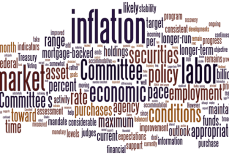Fannie Mae & Freddie Mac have made an announcement clarifying some key details after the…

Mortgage rates are expected to trend upwards
Mortgage rates are expected to trend upward as the Fed continues to confirm they will ease on their stimulus. Market trends reflect this today from recent new trending…..
The Federal Reserve’s fifth policy meeting of 2014 has wrapped up, and Chair Janet Yellen and her colleagues voted to trim another $10 billion from “quantitative easing,” the monthly asset purchases that the central bank has been using to juice the economy.
The new decision, coming at the end of a two-day meeting, cuts the total amount of bonds to be purchased next month to $25 billion, down from $85 billion per month last year. Bond purchases will be split between longer-dated Treasury securities and mortgage-backed securities. The Fed began winding down its asset purchases in December.
Short-term interest rates remain essentially zero; the federal funds rate, the main lever by which the Fed controls interest rates, is ultra-low, targeting between zero and 25 basis points, to give the economy full throttle.
Staying on course
All indications are that everything is on track for the Fed to proceed pretty much along the path that has already been laid out. Asset purchases are scheduled to wrap up in October. If the economy — measured namely via unemployment and inflation, but using other metrics as well — continues to move along as expected, then an interest rate increase could come sometime next year.
“Without pressure on wages in the labor market, inflation is not going to tick off in any substantial way. Velocity, the rate at which money is turning over, is approaching historical lows,” says Dennis Hoffman, an economics professor and director of the L. William Seidman Research Institute at Arizona State University’s W. P. Carey School of Business.
“If those conditions prevail, the Fed can continue with very accommodative monetary policy over the next year,” he says.
That may be a good thing. Even with a stronger-than-expected reading of second-quarter economic growth that came ahead of the Fed’s statement on Wednesday, the economic recovery is still struggling in some areas, notably housing.
Sketching the economy
The Fed releases a statement following every regularly scheduled monetary policy meeting. The carefully worded report tends to be nearly a verbatim copy from meeting to meeting, but the introductory paragraph offers a vague sketch of the central bank’s outlook on the economy, hitting on six major themes. Every monetary policy statement this year has offered assessments of: economic growth, the labor market and unemployment, household spending, business development, housing and inflation.
“The housing sector is a pretty good reflection of how consumers are feeling, and housing starts have been trending down the last couple of months,” says Mike Schenk, senior economist at the Credit Union National Association, or CUNA. “Now, they are substantially higher than the cyclical low but lower than they would normally be.”
“I keep going back and forth: A lot of the headline numbers look favorable, but the housing and softness in underlying numbers in the market cause concern,” he says.
For instance, new home sales floundered last month, falling 8.1 percent.
“New homes sales should have been up sharply, especially with mortgage rates coming down,” says Lance Roberts, general partner and chief portfolio strategist at STA Wealth Management in Houston.
A pick-up in inflation seen
The Fed did give a nod to increasing inflation.
“Inflation has moved somewhat closer to the Committee’s longer-run objective,” the statement read. Today’s reading of “personal consumption expenditures,” or PCE, the Fed’s favored inflation measure, showed that inflation in the second quarter of 2014 clocked in at 1.5 percent year over year, up from a revised 1.2 percent in the first quarter.
The central bank has an inflation target of 2 percent.
A delicate wind-down of bond-buying
Like a magician whipping a tablecloth out from under an elaborate place setting, the central bank is trying to maneuver away from the massive economic accommodation of quantitative easing, or QE, without upsetting the apple cart.
So far, so good on that front: While the Fed has been tapering its asset purchases, 30-year fixed mortgage rates have been declining, from 4.55 percent at the beginning of December to 4.28 percent last week, according to Bankrate’s weekly surveys.
“I’ve been one of the people saying there will be problems; I worry about the money printing. Maybe it will cause interest rates to rise instead of fall,” says Bud Conrad, chief economist at Casey Research, an investment research firm.
“A year ago, the world fell apart when the Fed talked about tapering; mortgage rates were nearly a full percentage point higher, but rates have fallen,” he says.
Applause from Wall Street
A less direct proxy for the success of the Fed’s monetary policy is the stock market. Though wages have been slow to follow, QE has “inflated asset prices and increased corporate profits,” says Roberts. The benchmark index, the Standard and Poor’s 500, is up more than 100 percent from five years ago.
That, it turns out, was part of the plan, according to Hoffman.
“There was such evaporation in wealth in 2008 and 2009. We needed to have an avenue to recoup some of that wealth. The Fed has provided an opportunity for that to happen,” he says.
The question is: What happens when the Fed stops providing the accommodation? Even more, what happens when it’s time to tighten rates? That’s when things will get interesting.
Read more: http://www.bankrate.com/financing/federal-reserve/fed-takes-back-more-of-the-juice/#ixzz38zPgoMeh



